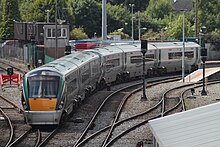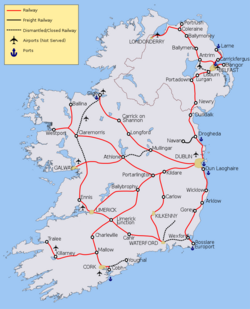| Ireland | |||||
|---|---|---|---|---|---|
 An Iarnród Éireann 22000 Class DMU at Drogheda MacBride station | |||||
| Operation | |||||
| National railway | Iarnród Éireann (Republic of Ireland) NI Railways (Northern Ireland) | ||||
| Statistics | |||||
| Ridership | 50 million (Republic of Ireland, 2019)[1] 15 million (Northern Ireland, 2017)[2] | ||||
| System length | |||||
| Total | 2,733 km (1,698 mi) | ||||
| Electrified | 53 km (33 mi) | ||||
| Freight only | 362 km (225 mi) | ||||
| Track gauge | |||||
| Main | 1,600 mm (5 ft 3 in) | ||||
| Electrification | |||||
| 1500 V DC | DART in Dublin | ||||
| Features | |||||
| Longest tunnel | Cork railway tunnel | ||||
| Longest bridge | Barrow Bridge | ||||
| No. stations | 147 | ||||
| |||||
Rail transport in Ireland (InterCity, commuter and freight) is provided by Iarnród Éireann in the Republic of Ireland and by Northern Ireland Railways in Northern Ireland.
Most routes in the Republic radiate from Dublin. Northern Ireland has suburban routes from Belfast and two main InterCity lines, to Derry and cross-border to Dublin.
The accompanying map of the current railway network shows lines that are fully operational (in red), carrying freight only traffic (in black) and with dotted black lines those which have been "mothballed" (i.e. closed to traffic but potentially easy to re-open). Some airports are indicated but none are rail-connected, although Kerry Airport and Belfast City Airport are within walking distance of a railway station. Both the City of Derry Airport and Belfast International (Aldergrove) are near railway lines but not connected. Ports are marked, although few remain rail-connected. Dublin Port, Larne Harbour, Belview Port and Rosslare Europort are ports that are still connected.
Ireland's only light rail service, named Luas, is in Dublin. No metro lines currently exist in Ireland, but there is a planned MetroLink line which would serve Dublin.
- ^ "Railway passenger transport statistics" (PDF). Europa EU. 8 December 2019. Archived (PDF) from the original on 11 January 2021. Retrieved 9 January 2021.
- ^ "40% increase in rail passengers on Derry line". Derry Journal. 25 September 2018. Archived from the original on 25 April 2019. Retrieved 25 April 2019.
